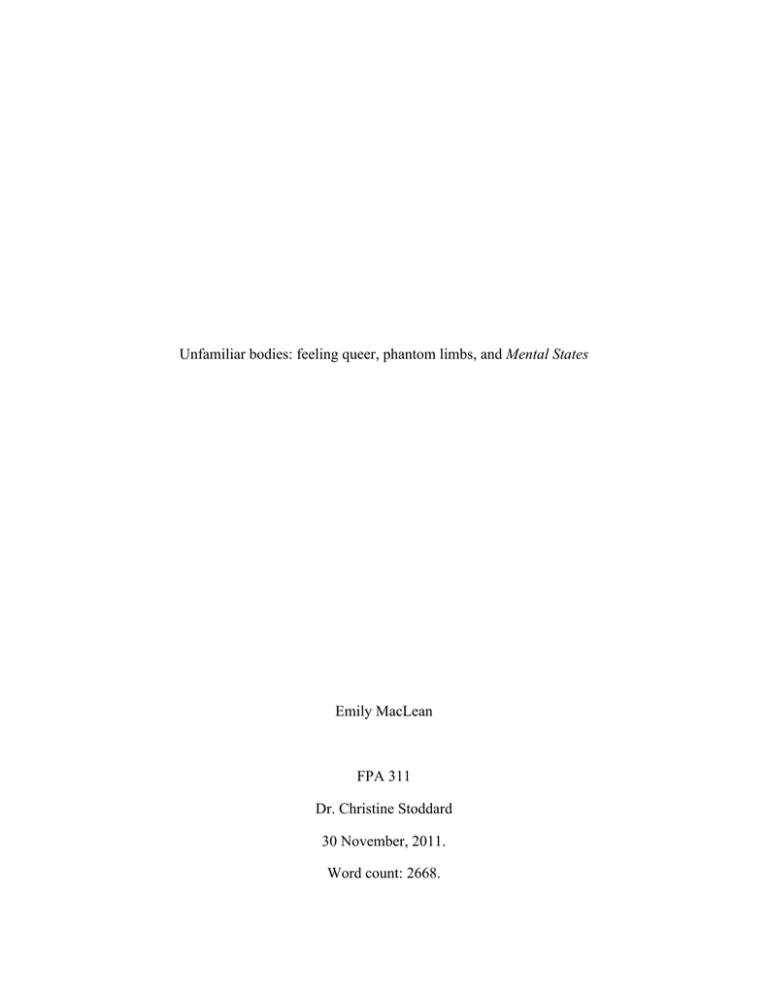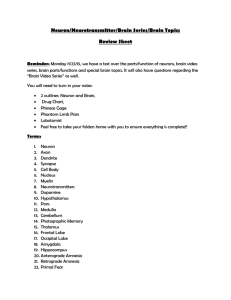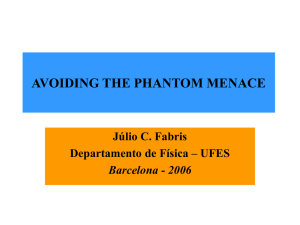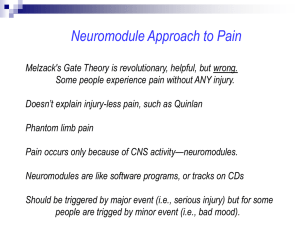Document 10574757
advertisement

Unfamiliar bodies: feeling queer, phantom limbs, and Mental States Emily MacLean FPA 311 Dr. Christine Stoddard 30 November, 2011. Word count: 2668. Scientifically and culturally enigmatic, phantom limb syndrome offers an interesting and timely space of overlap between human biology and cultural studies; how appropriate, given the relatively recent turn in critical theory towards the body and embodied responses. Still, despite this attention to bodies, to neither the scientific nor public communities would phantom limbs be considered regular or familiar matters of concern; thus, when such a disrupted figure is encountered, bodily responses of queer affects assemble and gather. Examining these negative affects closely may allow meaningful and informative interpretations of these nonvisible appendages to take shape. I would suggest that the predominantly queer affects that float around phantom limbs, as well as their duality of absence and presence permit an uncovering of societal ideals of the physically complete body, while also underscoring the complete integration of the mind and body. This uncovering and integration allow for new understanding of George Condo’s traditionally psychoanalysed portraits, Mental States. Though the clearly defined parameters of Silvan Tomkins’ specific affects make them appealing, in this essay the term “affect” will more resemble closely the “unqualified”1 intensity Brian Massumi articulates in his “canonical”2 text, “The Autonomy of Affect”. Certainly the scope of affects Tomkins described in Affect, Imagery, Consciousness is reasonably inclusive of regularly felt emotions, but because phantom limbs are so unfamiliar it does not seem appropriate to designate the affects they generate so rigidly. Additionally, phantom limbs are not objects most people encounter every day, so the “descriptive levelheadedness”3 of Tomkins’ emotion-affects is unsuitable to meet these invisible appendages. Rather, these limbs generate an array of feelings and interpretations and so offer a 1 Brian Massumi, “The Autonomy of Affect,” Cultural Critique 31 (1995): 88. Patricia T. Clough, “The Affective Turn: Political Economy, Biomedia and Bodies,” Theory Culture Society 25 (2008): 3. 3 Eve Kosofsky Sedgwick and Adam Frank, “Shame in the Cybernetic Fold: Reading Silvan Tomkins,” Critical Inquiry 21, no. 2 (1995): 500. 2 myriad of affective responses. This is not to say that queer or negative affects, so important to Tomkins’ theory, are not generated by phantom limbs, but the all-stopping, all-disabling shame of his philosophy does not necessarily have to manifest itself. In my case, this discomfort has prompted me to question why I feel “bad” when I see someone living without a limb, someone who may be afflicted with phantom limb syndrome. For me, from talking to classmates, and from reading various critical and neurological articles, it seems that few positive or otherwise “good” affects originate from phantom limbs; to most people the prospect of living with a shadow of one’s former limb is not a happy end. Perhaps this is why unpleasant affects surround them, but significantly, these bad affects may impede an individual’s ability to be affected and take any understanding from the limb. Here, however, this negativity is the starting point, and these bad feelings are not going to incapacitate just yet. Phantom limb sensation and its associated syndrome follow “most”4 cases of amputation. As H. N. Lukes discusses at length in “Causalgia of the Heart,” phantom limb syndrome is a unique condition because it is an intersect of language and feeling; as the symptoms of phantom limb syndrome are not immediately apparent to an observer, discourse is needed to become aware of the condition: “its invisibility requires narration by the sufferer.”5 Once a phantom limb’s presence has been made apparent, the disabled body seems to delve even further into the unusual and truly becomes a queer assemblage; initially, the site of the lost limb produces negative affects of anxiety and fear, but the site’s new appendage creates queer affects of disorientation, confusion, and incomprehension. I would offer that there are different sets of affects associated with phantom limbs: those associated with a 4 Giummarra and Moseley, 524. H. N. Lukes, “Causalgia of the Heart,” Women and Performance: a journal of feminist theory 19, no. 2 (2010): 253. 5 physical body existing without a certain limb, and those associated with the existence of an invisible and, in a way, virtual phantom limb. The two sets of affects work together to inform and expose societal ideas of corporeal normalcy and demonstrate the singularity of the mindbody. Disability theorists such as Petra Kuppers argue that people designated as “disabled” have adapted to a new lifestyle, and that their condition should not be characterised by loss because their newly-evolved lives are “dignified… full of potential and specialised skills.”6 This stance is reasonable and well-informed (Kuppers is herself a wheelchair user7), but despite these and other progressive assertions by actual disabled members of the population, contemporary society still regards those born without limbs, hands, or other body parts as disadvantaged and somehow less capable than those born with a familiar, complete body. Fear and anxiety arise with the possibility living with fewer limbs: a body part that is removed from the anatomically normal position is still considered lost or missing, contrary to recent theorising. Limblessness raises tensions, worries over bodily security, and confusion about the incomprehensible life without a limb. People are empathetic; they do not want to be presented with a body missing a limb because a visualisation of that body’s life is then imaginable. This idea can be reflected back on to the individual, raising affects of fear and distress as a result of felt attachment to the complete body. By provoking these negative affects, the physically absent limb reveals common ideals of corporeal normalcy, and shows the extent to which most people are unsettled by the prospect of a limbless lifestyle. Clearly, it will take time for common opinion to change 6 7 Petra Kuppers, “The Performance of Disability,” The Drama Review 51, no. 4 (2007): 81. ibid. regarding unusual physical bodies, though critical and academic changes are happening in some disciplines. The characteristic of phantom limbs that is perhaps troubles people most is their unregulated movement, which happens without conscious control and often finds the limb contorting in physically impossible positions8. The body part that once exhibited action only when consciously prompted by the somatic nervous system has been replaced by a new, unfamiliar part that moves and reacts to stimuli other than conscious nervous input; seemingly, this phantom body part acts of its own accord. A limb that does whatever it wants is admittedly a very unsettling idea, and one that, as mentioned previously, raises queer affects. The uncontrollable motion of phantom limbs is one of their most remarkable qualities, but importantly, this ability brings attention to how body and mind are not arranged in the Cartesian manner; the “trouble” with phantom limbs is that they take down this paradigm. In multiple ways, phantom limbs demonstrate the singular continuum of mind and body. The prevailing societal opinion is that the body is somehow subservient to the mind, that there is a split between the ephemeral and intangible mind or soul, which subsequently finds the merely physical body under the control of the greater mind. Descartes greatly progressed and validated this principle, particularly by his writings in “Second Meditation: Of the Nature of the Human Mind; and that it is Easier to Know than the Body”. He deduced that perceiving the outside world was nothing more than thinking, indicating a superiority of the mind over the body and, therefore, its separate existence. His statement on the nature of bodies further expresses the inferiority and division of the body with respect to the mind: 8 Melita J. Giummarra et al., “Mechanisms underlying embodiment, disembodiment and loss of embodiment,” Neuroscience and Biobehavioral Reviews 32 (2008): 145. By body, I understand … that [which] can be contained in some place and fill a space in such a way that any other body is excluded from it; that can be perceived either by touch, sight, hearing, taste or smell; that can be moved in many ways, not of itself, but by something foreign to it by which it is touched and from which it receives the impulse. For as to having in itself the power to move, to feel and to think, I did not believe in any way that these advantages might be attributed to corporeal nature.9 Descartes’ belief that the mind delegates actions and the body merely follows directions is clearly stated; all a body can do is react to a “foreign impulse” (originating in the mind). The unimportance he assigned to his form, “I am not this assemblage of limbs called the human body”10, indicates his privileging of the mind (actual self) over the corporeal (physical shell). To Descartes and many people today, a person is still governed and defined by a mind or soul, and the body is merely “a phantom… temporarily constructed purely for convenience”11. Because of the ubiquity of this paradigm, imagining of the self not as something special or separate from their corporeal self is unnerving, but this is a thought phantom limbs provoke. Now, consider scientific literature on phantom limbs in relation to the Cartesian division of body and mind. Descartes is, obviously, not at fault for not knowing the motor and neural pathways that allow translation of thought into bodily movement, but current scientific literature should lead a contemporary realisation of this connectivity, with phantom limbs as an exemplary case of this non-hierarchical arrangement. Proprioreceptors and visual receptors are involved in the detection of limb movement; through signal transduction pathways, notice of stimuli and response are sent between limb and sensory and integrating cortices. However, these receptors and pathways can be deceived with relative ease, and it is thought deception of these 9 René Descartes, “Second Meditation: Of the Nature of the Human Mind; and that it is Easier to Know than the Body,” in The Body, ed. Tiffany Atkinson, (Hampshire: Palgrave MacMillan, 2005): 28-9. 10 ibid., 29. 11 V. S. Ramachandran and Sandra Blakeslee, Phantoms in the brain: probing the mysteries of the human mind (NY: William Morrow & Co., 1998): 58-9. mechanisms is similar to how phantom limbs are sensed. For example, experiments with sensory receptors show that even when a person is touched at a specific location B and knows they are not being touched in location A, they still feel the sensation in location A12. In a Cartesian sense, it would seem that paradoxically, the body has the final say in interpreting the stimuli, not the mind. However, when thinking about the body as an entire unit, this apparent paradox is less puzzling: the mind and body together experience the stimulus, because the individual is a body, of which the mind is an important part. Lukes proposes that “you only provisionally have a body”13, but I contend that if one merely ‘had’ a body, phantom limbs would never be sensed, because the mind’s position of ownership would result in complete control over sensory perception. In some cases, the phantom limb performs “incipient motor acts” that the physical limb would have performed when it was in place14. Actions may be more reflexive, such as reaching out to break a fall, but often the phantom limb continues to interact with the environment in the manner of the absent physical limb. Additionally, consider the empathetic nature of phantom pain, which can be initiated by the sight or even imagination of pain in another person15; this can provoke cramping and spontaneous movement of the phantom16 that the patient actually feels. These activities are not under conscious control, that is, the mind does not inform the actions of this virtual limb. The phantom limb is acting of its own bodily accord, but nevertheless produces real, measurable sensations. A separate, body-governing mind would not allow these sensations to be realised in a person. 12 Giummarra et al., 146. Lukes, 233. 14 Giummarra et al., 148. 15 Giummarra and Moseley, 525. 16 ibid., 526. 13 In treating phantom limb syndrome, comprehensive programs that address the brain and mechanics have proven most successful. Because continued perception of a phantom limb is the result of body scheme (fluid representation of the spatial and mechanical properties of the body due to sensory inputs17) integrated with body image (a more conscious idea of the body including its place in relation to the environment18), use of case-specific drugs and “tailored psychological, physical, and behavioural paradigms”19 are employed together to assist patients with pain and nagging phantom actions. The science of phantom limbs and their treatment accommodates the integrated nature of the mind and body; it speaks to the strength of their connection that even when considering a body physically missing a part, the unity of mind and body prevails against the negative feelings the phantom limb produces. See Condo’s work at <http://www.thelodownny.com/leslog/2011/01/george-codos-mental-states-cometo-the-new-museum.html> The portraits of New York-based artist George Condo can be read in light of the previously discussed ideas of negative affects, anxiety regarding “incomplete” bodies, and integration of body and mind. For much of his recent career, Condo has painted portraits of strange-looking people with disfigured faces and often oddly-contorted bodies in smaller collections (for example, “Melancholy” and “Manic Society”) that fit within his greater theme and body of work, Mental States. Most readings of Condo’s work have focused on psychoanalytical aspects of expression and psyche of subjects, but given that Condo is painting human bodies, bodily responses in viewers follow. 17 Giummarra et al., 146. ibid., 147. 19 Giummarra and Moseley., 526. 18 Seated Nude (2005) [see appendix] is a painting of a naked woman sitting back straight, neck hunched-over on the floor; one impossibly long leg is outstretched in parallel with her equally impossibly long neck. Her pose would indicate resignation or defeat, except that her incredulous/complacent face, with its two different-sized and –coloured eyes, gazes straight at the viewer. She has a severe under-bite and huge ears, but is still completely recognisable as a human figure. The painting’s tones are natural browns, except for the bright blue eye, which, as a result, is the focal point. The disproportioned body and rather sadly grotesque face raise negative affects of repulsion, pity, and confusion, for this is an unfamiliar body, foreign, and somehow ‘wrong’. As with disabled people discussed previously, the impression is that the Nude is somehow incapable because of her appearance (which again reveals wishes for bodily normality), though Condo asserts that his painted subjects are “ordinary, nice people”20. However, he does acknowledge that his subjects, including Seated Nude, evoke anxieties which “counter-[affect] the desire… deflecting it and making it impossible for it to reach its satisfaction”21; Seated Nude does not allow desires of regular corporeality to be realised because her body is too strange, in a way reminiscent of a limbless body. The mental state of complacency of Seated Nude is extended to her entire physical being; she inhabits a visible and total state of bodily intensity or affect. This state differs but is similar to a phantom limb. Lukes proposes that phantom limbs are “a kind of pure neurological affect”22 created and experienced by the entire body; I think this definition works nicely with what a phantom limb is. Like “Seated Nude”, individuals with phantom limbs exist in a perpetually affected state, though theirs is not immediately obvious, but in both cases it is the body and mind 20 George Condo, “George Condo,” interview by A. Bonney. BOMB, 40, Summer 1992, 34. ibid., 36. 22 Lukes, 235. 21 as a unit that finally affect the individual. Seated Nude and phantom limbs demonstrate that what happens “in your head” does not necessarily stay there: events of the brain are, in the end, events of the body. Instead of feeling incapacitated when queer and negative affects arise, the individual that is feeling queer should pause and reflect on the cause of these strange affects. The apparent contradiction of absence and presence that characterises phantom limbs results in queer affects of anxiety, confusion, and insecurity, but after examining where these feelings stem from, some new understanding of bodies has been realised. The phantom limb’s existence is always permitted in conjunction with the absence of a physical limb; the lack of limb raises worries in other bodies about their own physical completion, revealing unspoken desires for a physically whole body. The site of the absent body part often is taken up by a neurologically- and corporeally-detected phantom , which demonstrates the integrated nature of the body and mind and dismisses the Cartesian superiority of the conscious psyche. But, these seemingly internal affects manifest themselves throughout the entire body, as shown in George Condo’s “Seated Nude”; the neurological affects that afflict an individual are never purely in the psyche, but always permeate to the physical limits of an individual. It is not always comfortable to be so intensely affected, but by reading the affects one experiences, cognisance may be gleaned from encountering objects; thus, feeling queer and intrigued by the world allow a greater engagement with it. As Condo remarked, “the affected part of people is the interesting side to me.”23 23 ibid., 35. Works Consulted Clough, Patricia T. “The Affective Turn: Political Economy, Biomedia and Bodies.” Theory Culture Society 25 (2008): 1-22. Condo, George. (1992, Summer). George Condo [Interview by A. Bonney]. BOMB 40, 34-9. Descartes, René. “Second Meditation: Of the Nature of the Human Mind; and that it is Easier to Know than the Body.” In The Body, ed. Tiffany Atkinson. Hampshire: Palgrave MacMillan, 2005. Giummarra, Melita J. and G. Lorimer Moseley. “Phantom limb pain and bodily awareness: current concepts and future directions.” Current Opinion in Anaesthesiology 24 (2011): 524-31. Giummarra, Melita J. et al. “Mechanisms underlying embodiment, disembodiment and loss of embodiment,” Neuroscience and Biobehavioral Reviews 32 (2008): 143-60. Kuppers, Petra. “The Performance of Disability.” The Drama Review 51, no. 4 (2007): 80-88. Lukes, H. N. “Causalgia of the Heart.” Women and Performance: a journal of feminist theory 19, no. 2 (2010): 227-246. Massumi, Brian. “The Autonomy of Affect.” Cultural Critique 31 (1995): 83-109. Ramachandran, V.S. and Sandra Blakeslee. Phantoms in the brain: probing the mysteries of the human mind. New York: William Morrow & Co., 1998. Rugoff, Ralph. George Condo: Mental States. London: Hayward Publishing, 2011. Sedgwick, Eve Kosofsky and Adam Frank. “Shame in the Cybernetic Fold: Reading Silvan Tomkins.” Critical Inquiry 21, no. 2 (1995): 496-522.





